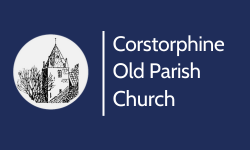
History
A very brief history
Historically, the focal point for many villages is the parish church. Corstorphine, arguably, is no different; and the Parish Church of St. John the Baptist has stood on this site since 1429. Some may not know, however, that it stands on the site of a previous parish church. The earliest reference we have to the village is a charter dated 1128, bequeathing the ‘...chapel at Crostorfyn…’ to the Abbey of Holyrood.
The exact whereabouts of this chapel, which was dedicated to St. Mary, is a matter of conjecture. Generally, it has been accepted that it stood on the site of the present parish church now occupied by the North Aisle. Another location offered is now where the north part of the Nave stands.
The Forresters
We know that Adam Forrester purchased the land of Corstorphine from the More family of Abercorn during 1374; and a 1376 confirmation charter evidencing this still exists. Adam sought physical security by building his castle, between Dovecot Road and Castle Avenue as soon as he could; and he also provided ecumenical security for him and his family by building his own chapel very close to the ‘St. Mary Chapel’. Dedicated to St. John the Baptist, this chapel was intended to allow parishioners to say masses and prayers for the Forrester family; in addition to their regular worship to St. Mary. A concept known as the ‘chantry chapel’.
Adam died in 1405 and his son, John, extended his father’s chapel by possibly building eastwards; providing the Nave, Chancel and Sacristy (now the Vestry) and westwards, building the bell tower. This became a ‘collegiate church’; managed by a provost who oversaw a ‘chapter’ of non-monastic priests that would officiate at the church for predetermined periods of time. Provision was also made for singing choir boys; who would have to learn Latin in order to assist with liturgical services. So, it was seen, quite literally, as a college in the sense of a place of learning. This collegiate church was founded in 1429; and was given Papal recognition in 1444.
The Reformation
Up until the Reformation, the St.Mary Chapel and the Collegiate Church functioned alongside each other; one for regular worship and the other as a chantry chapel. Post reformation reconstruction saw the dismantling of the St. Mary Chapel in 1646; and it is likely that the stones from this building formed what is now the Entrance Porch. The Collegiate Church then became the Parish Church. Much building work has taken place over the years; doors have been added and taken away, as have galleries and family aisles.
Reconstruction
The 1905 restoration by the architect George Henderson, arguably, has redeemed the Medieval layout of the Church; and it houses many treasures: a fourteenth century baptismal font; the tombs of the Forrester family, memorial stones, pre-reformation relics, masons’ marks and carvings.
Stephen Murray, Volunteer Steward, Corstorphine Heritage Centre.
This part of our website is under construction as we ready ourselves for our 600th anniversary.
In the meantime, if you have a question about our history our partners at Corstorphine Heritage Trust will be able to help.

